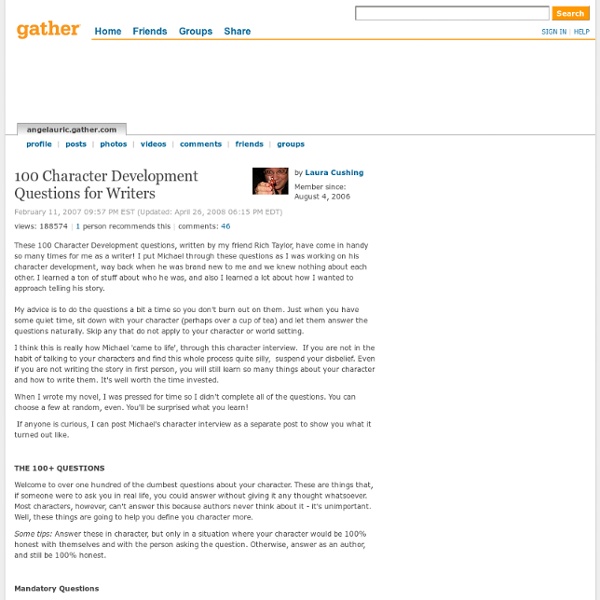



http://www.gather.com/viewArticle.action?articleId=281474976908598
6 Ways to Make Sure Your Reader’s Brain Syncs with Your Protagonist’s Brain photo by Andres Musta via Flickr Because here’s the thing: it’s not fiction. It’s fact. Except, you know, for the Vulcan part. Interviewing Characters: Follow the Energy - Conversations with Dale On November 13, 2007 I ran out of plot for the NaNoWriMo novel I was writing. I had no idea what to write next. That’s not uncommon for NaNo novelists, but I hadda do something to jiggle myself loose.
Fiction Writer's Character Chart - EpiGuide.com If you're a fiction writer -- whether you're working on a novel, short story, screenplay, television series, play, web series, webserial, or blog-based fiction -- your characters should come alive for your reader or audience. The highly detailed chart below will help writers develop fictional characters who are believable, captivating, and unique. Print this page to complete the form for each main character you create. IMPORTANT: Note that all fields are optional and should be used simply as a guide; character charts should inspire you to think about your character in new ways, rather than constrain your writing. Fill in only as much info as you choose. Have fun getting to know your character!
Medieval Names Archive This collection of articles on medieval and Renaissance names is intended to help historical re-creators to choose authentic names. These articles were gathered from various places, and some of them appear elsewhere. In all cases, the copyright on each article belongs to its authors. For frequent users, we offer a compact index; but please read the following introduction at least once. What's New Choosing a Medieval Name
Character and Characterisation in the Novel How to write convincing characters Characterisation - the task of building characters - isn't easy. But if you're struggling to build characters with real life and vigour, just follow these rules. If you do follow them correctly, we can pretty much guarantee that your characterisation will be just fine! Know what kind of character you are writing Creating Stunning Character Arcs, Pt. 1: Can You Structure Characters? What if there were a sure-fire secret to creating stunning character arcs? Would you be interested in discovering it? If you care about connecting with readers, grabbing hold of their emotions, and creating stories that will resonate with them on a level deeper than mere entertainment, then the answer has to be a resounding yes!
Science Fiction Writer Robert J. Sawyer: On Writing — Dialogue SFWRITER.COM > How to Write > On Writing: Dialogue by Robert J. Sawyer How to Write a Character Sketch: Learning More About Your Characters’ Motivations and Personalities Regardless of the type of writing you are doing, knowing who your characters are and knowing them well will add greatly to your work. Understanding your characters’ personalities through a character sketch helps you to understand where they are coming from and what motivates them. This, in turn, helps you understand what drives all of the action in your work, and the clearer this is, the easier your audiences will be able to connect with your writing. But how do you go about writing a character sketch?
Character Chart FAVORITES Color: Music: Food: Literature: Expressions: Book: Quote: Expletive(s) (swears): Mode of transportation: HABITS Smokes: What? How often? Drinks: What? How often? Worst bad habit? Sleep learning is possible: Associations formed when asleep remained intact when awake Is sleep learning possible? A new Weizmann Institute study appearing August 26 in Nature Neuroscience has found that if certain odors are presented after tones during sleep, people will start sniffing when they hear the tones alone -- even when no odor is present -- both during sleep and, later, when awake. In other words, people can learn new information while they sleep, and this can unconsciously modify their waking behavior. Sleep-learning experiments are notoriously difficult to conduct. For one thing, one must be sure that the subjects are actually asleep and stay that way during the "lessons."
Physical Descriptions - List of Hair Colors Hair Color List (Note: an updated and expanded version of this list appears in my 15K-word book How to Describe Hair and Skin. See below.) [First, my profound apologies to the vast majority of readers who don't steal content, but I have to state the following. This article and all content on this website belongs to Val Kovalin, copyright © Obsidianbookshelf.com, except where noted. Unauthorized use and/or duplication of this material without written permission from Val Kovalin is strictly prohibited. Excerpts and links may be used, provided that full and clear credit is given to Val Kovalin and Obsidianbookshelf.com with a return link to the original content.]
Tami Cowden I am happy to say that The Complete Writers’ Guide to Heroes and Heroines is now available on Kindle! And even better – so is Fallen Heroes: Sixteen Master Villain Archetypes! What are the Sixteen Master Archetypes? The word "archetype" was coined by Carl Jung, who theorized that humans have a collective unconscious, "deposits of the constantly repeated experiences of humanity.... a kind of readiness to reproduce over and over again the same or similar mythical ideas...." This shared memory of experiences has resulted in a resonance of the concepts of hero and heroine that transcends time, place and culture.